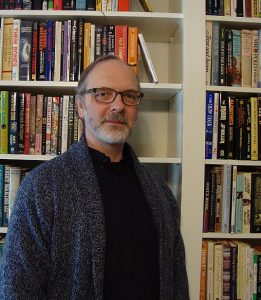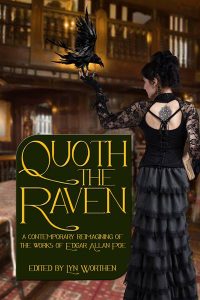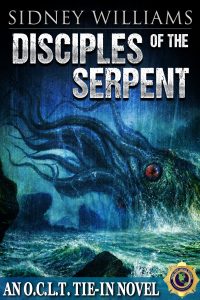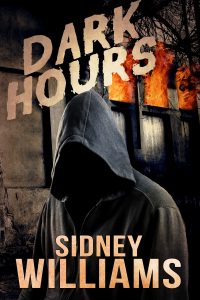The anthology Quoth the Raven launched today, and I just had the pleasure of interviewing an author with a story in that book, Sidney Williams.
 Sidney Williams is the author of several novels including the recent Disciples of the Serpent, the short novel Dark Hours and the thriller Midnight Eyes. He’s also written the horror thrillers When Darkness Falls, Blood Hunter, Night Brothers and Azarius. Additionally, he wrote three young adult horror novels under the name Michael August, and he has scripted comic books in the horror genre as well. All of his books have been released in audio and ebook editions from Crossroad Press. Sidney’s short work has also appeared in the magazines Cemetery Dance, Eulogy, Sanitarium and in diverse anthologies including Under the Fang, Demon Sex, Crafty Cat Crimes and Hot Blood: Deadly After Dark. Sidney previously worked as a journalist, librarian and a writer of corporate communications. He teaches creative writing at Full Sail University with a focus on horror, mystery and suspense.
Sidney Williams is the author of several novels including the recent Disciples of the Serpent, the short novel Dark Hours and the thriller Midnight Eyes. He’s also written the horror thrillers When Darkness Falls, Blood Hunter, Night Brothers and Azarius. Additionally, he wrote three young adult horror novels under the name Michael August, and he has scripted comic books in the horror genre as well. All of his books have been released in audio and ebook editions from Crossroad Press. Sidney’s short work has also appeared in the magazines Cemetery Dance, Eulogy, Sanitarium and in diverse anthologies including Under the Fang, Demon Sex, Crafty Cat Crimes and Hot Blood: Deadly After Dark. Sidney previously worked as a journalist, librarian and a writer of corporate communications. He teaches creative writing at Full Sail University with a focus on horror, mystery and suspense.
And now, on to the interview:
Poseidon’s Scribe: How did you get started writing? What prompted you?
Sidney Williams: I guess I always had an inclination toward storytelling. Maybe all kids do, and writers just never let it go. Family legend held that my dad had a grand imagination as a child, and he had a ghostly story or two when I was young. He ventured into a creaky old abandoned house once upon a time, found a large tin lid of some sort and sailed it through an open doorway into the next room. He heard it hit the wall and fall to the floor.
Then seconds later, the lid came sailing back. This would have been the ‘30s, so very likely a homeless person was sheltering in the house, picked the lid up and threw it back, but he took it at the time as a haunt and made tracks.
Stories like that captured my imagination as a kid, and my dad read me comics of all sorts. Tarzan and the old Ripley’s Believe it or Not from Gold Key stand out. The Ripley’s stories chilled me. It was really just a horror anthology comic with loose ties to legends. There was one with a haunted tree that grabbed people that had me hiding under the covers. I should mention since this interview was prompted by a new Poe-themed anthology that my dad also read to me from a Whitman collection of Edgar Allan Poe tales around that same time. “The Gold Bug” fascinated me. “The Raven” scared me. I didn’t fully understand it, but the mood and tone had me hiding under the covers also.
As soon as I could figure out how to put pen to paper, I started composing stories of my own and really never stopped. Handwritten stories gave way to little pieces hammered on a manual Smith Corona that was around the house, and eventually we got an electric Smith Corona and I wrote my first trunk novel on that, constantly battling ribbon depletion. They didn’t make their ribbon cartridges for novelists in those days.
P.S.: Who are some of your influences? What are a few of your favorite books?
S.W.: Quoth the Raven has really reminded me of the Poe influence or caused me to do a little personal archaeology. The Poe influence is due in part thanks to my dad and in part because Poe was in the mix of stories we studied in school. My 11th grade English teacher was a young woman, probably in her thirties, Ivory Thomas. She really encouraged creative writing and sometimes had us work from prompts. Once she put up a transparency of an old dark house, and I wound up writing a vampire story from the point-of-view of the vampire’s houseboy. She said it reminded her of Poe and encouraged me from that point forward, and she’d call me out if I ever slacked on an assignment. I made a low grade on something I wasn’t interested in, and she said something like: “We all need to focus better. We don’t need to be talking in class with our 36-point test papers.” Mine was the 36, of course. Sadly she passed away that same school year from a brain tumor. It was very sad. I’ll never forget her, and I owe her a debt.
There were many other influences. I purchased some books through a circular at school, Stories of Suspense, Horror Times Ten and Gooseflesh. Those included Ray Bradbury’s “The October Game,” August Derleth’s “The Lonesome Place,” Jack Finney’s “Contents of a Dead Man’s Pockets” and a lot of other great ones. The short story version of “Flowers for Algernon” was in one. I followed those with more Bradbury. The stories in The Illustrated Man amazed me. I was lucky enough to interview him in the ‘90s when I worked as a journalist, and my article about him used The Illustrated Man as a framing device.
I went through a Sherlock Holmes phase as well in junior high, read Ellery Queen’s Mystery Magazine then Stephen King in high school, some H.P. Lovecraft including “The Shadow Over Innsmouth.” Then I discovered Raymond Chandler and Ross MacDonald and loved those books.
I could go on and on here. I’m a book hoarder. It’s an illness, I guess, but it’s not a bad one. I’ve latched onto the Japanese term Tsundoku. It’s not 100 percent aligned, but it serves, and there’s a line from, I think a Harlan Ellison story that was adapted for The New Twilight Zone series in the 80s. Someone asks Danny Kaye if he’s read all the books he owns, and he responds: “What would I want with a library full of books I’ve already read?”
P.S.: Suppose you’ve traveled through time and met yourself at a point when you were first thinking of being a writer. What one thing do you tell this younger version of you?
S.W.: Slow down. As I’ve probably revealed here, I was hammering away at stories when I was very young. I was pretty driven. In hindsight, we have the wisdom of understanding that things happen in their own time.
 P.S.: Within the Quoth the Raven anthology, your story is “A Cooler of Craft Brew.” Please tell us something about the story, and how it connects with Poe’s classic tale “The Cask of Amontillado.”
P.S.: Within the Quoth the Raven anthology, your story is “A Cooler of Craft Brew.” Please tell us something about the story, and how it connects with Poe’s classic tale “The Cask of Amontillado.”
S.W.: I read “The Cask of Amontillado” in 10th grade English, and we dissected it in class. The concise impact struck me once I really understood it, especially the final ringing of the bells on Fortunato’s motley.
We had to look up what a motley was in an adjacent assignment. One guy drew a picture with his work. It’s amazing all of the things that come back to you. It became one of those stories that’s fixed in your imagination, always a part of it along with the moment of discovery, of your mind opening up just a little.
I’ve lived in Orlando, FL, for more than six years now, and I’ve, of course, watched the news a lot. One morning I saw a story about a man who attempted something that made me think, that’s like a Florida variation on “Cask.” What if he’d succeeded? I cataloged the idea and came back to it after a while when the story and the characters had kind of gelled. There are many jokes and even a Twitter feed aggregating all of the “Florida man” headlines, and I decided there might be an answer for what causes all of those bizarre acts. As I was finishing the story, another news story emerged of another incident quite similar, so on it goes, another Florida man, another act of aggression.
I tried to weave Florida realities and domestic drama into a reimagining of “Cask,” and I tried to weave in some flourishes true to the Poe story while also tapping into the aggrievement driving the tale, making it Florida-appropriate. The original story is a little vague on the “thousand injuries of Fortunato.”
P.S.: You’ve authored a handful of comic books. Please discuss that process. Do you do the artwork yourself? What are the major differences between writing comic books and writing pure text stories?
S.W.: I’m purely a writer. My kindergarten teacher was about, I don’t know, 200 years old, and she deployed what was even then an outmoded technique. She changed me from writing with my left hand to my right, and I’m somewhat ambidextrous these days, but I’m no artist.
I read comics and loved comics from the time my dad read them to me. After my first novels were sold back in the Paperbacks from Hell-era, I hit the convention circuit. I met Roland Mann. He’d later work for a division of Marvel. At the time, he was writing comics for companies like Caliber and Malibu Graphics and also working to package the work of others, pairing artists with writers then selling the finished products to publishers.
I scripted several miniseries including one called The Mantus Files about a paranormal investigator in New Orleans who’d survived being the son of a cultist who tried to sacrifice him. We did a funny horror comic called The Scary Book that I’m really proud of, and I wrote an action-adventure comic. It was loads of fun.
Writing comics is like writing for any visual medium. Storytelling is storytelling but you’re devising the story in pictures for an artist to draw, so it was really a matter of channeling ideas into a new form. I’d read articles about styles of comics scripting somewhere along the line, so I had some familiarity with the style Roland wanted to use, the Marvel style. That’s writing the storyline first then adding dialogue after the illustrations are done. I really just dived in. I’m basically an intuitive writer, so everything seemed to click.
P.S.: In what ways is your fiction different from that of other horror authors?
S.W.: My work is a bit eclectic, which has hurt me a bit. I guess in general I’m a suburban Southern writer, or maybe you could call it New South horror and suspense. I grew up in the suburbs of a small Southern city, and much of my work reflects the world I grew up in, which is a bit like suburban life anywhere but with dashes of the rural South creeping in. That means occasionally someone from a Faulkner story strolls into your world.
I worked for a daily newspaper that exposed me to a lot of a cross section of day-to-day life in the South, the world outside the cities.
My vision and worldview have expanded a lot since I was first writing. My worldview has expanded, and I’m in a new phase of productivity after a bit of a hiatus in the early aughts. The work I did publish in that time such as a graphic novel called The Dusk Society from Campfire Comics visited some of that same suburbs-meets-horror, I guess.
 P.S.: You’re the author of Disciples of the Serpent, which is an Orphic Crisis Logistical Taskforce tie-in novel. Please tell us a little about the novel, and about O.C.L.T.
P.S.: You’re the author of Disciples of the Serpent, which is an Orphic Crisis Logistical Taskforce tie-in novel. Please tell us a little about the novel, and about O.C.L.T.
S.W.: The book’s a bit Dan Brown meets H.P. Lovecraft, to put it in the terms we sometimes use these days to describe intellectual properties.
Speaking of expanding, that was an interesting and exhilarating novel to write. David Niall Wilson is the proprietor of Crossroad Press that brought a lot of my Paperbacks from Hell-era work back into print.
The O.C.L.T. series is his creation, a shared-world with multiple authors working in the vineyard, so to speak. The task force responds to strange and bizarre phenomenon around the world. That usually translates to giant monsters or magical creatures, vicious reptile creatures in the New York Subways, an Aztec monster, a series of strange hangings in Oregon. David, who’s a very prolific horror and dark fantasy writer, has contributed to the series and is familiar with shared worlds having written a Star Trek novel and several Stargate novels. Aaron Rosenberg and David Bischoff, who’s written quite a few Aliens and Star Trek novelizations, have also contributed.
My contribution, Disciples, is set in Ireland. A counter terrorism expert, Special Detective Aileen O’Donnell, is thrown onto a sub-rosa unit of the Irish Garda and joins with a member of the O.C.L.T. to investigate a series of ritualistic murders. They soon discover a decades-old thought experiment gone wrong. Cultists have actually tapped into ancient wisdom that might awaken the serpents St. Patrick drove out of Ireland, and they’re not little serpents. It builds to a battle that was a lot of fun to write.
My wife and I toured Ireland a few years ago, and I drew on our visits to ruins and a criss-cross of the country to fuel the story. David, who served in the U.S. Navy, helped with details for some scenes at sea. The great fantasy artist Bob Eggleton did the cover. I like to say the thing you see on the cover is just the tip of the iceberg.
 P.S.: Your novel Dark Hours also features a female protagonist. What challenges did you experience while writing from a female character’s perspective?
P.S.: Your novel Dark Hours also features a female protagonist. What challenges did you experience while writing from a female character’s perspective?
S.W.: Like a lot of writers, I’m empathetic, so I find myself fairly comfortable with dropping into a character’s head.
Ross MacDonald, creator of the detective hero Lew Archer, once said: “I am not Archer, but Archer is me.” I can at least understand that.
That’s not exactly true of my heroine, Allison Rose, but she’s a product of me and swatches of my empathy and intuition are in her fabric. She’s influenced by several remarkable women I’ve known through the years also, so she wasn’t a struggle to write.
With that said, men frequently have a different approach to the world than women do. The world treats men and women differently, so that’s inevitable. The male approach is often to hit something, though that’s oversimplifying, I suppose.
My wife, Christine, is a pretty remarkable woman also. Especially with Dark Hours whenever I’d find Allison confronted with a difficult situation, I’d check with Christine to see how she’d deal with it, and I shaped Allison’s responses with some of that insight.
P.S.: I love the reason you chose Sidisalive.com as your website’s name. Please repeat that story for my readers.
S.W.: Chicago writer Wayne Allen Sallee, author of The Holy Terror and The Shank of the Night, is a dear friend of mine. We met at a World Fantasy Convention years ago and have been close ever since. Wayne’s family roots are in Kentucky, so he used to make frequent trips to the Louisville area.
Wayne’s a bit of a photographer also, so once, while he was looking around at the old tuberculosis hospital, the Waverly Hills Sanatorium, sometimes called one of the most haunted sites in America, he snapped photos.
Spray-painted on one of the pillars in front was the phrase: Sid is Alive. It may have been the work a fan of Sid Vicious of the Sex Pistols, but it was kind of fun to see it. The early era of my writing life was winding down at that point, so that phrase seemed like a great declaration as a domain name. Still here. Still kicking. I’ve thought about making arrangements to have it convert to Sid is Dead dot com when that day arrives, but so far I haven’t really acted on that. That’ll be up to some nephews of mine, I guess.
P.S.: It’s so nice that you teach creative writing, passing on your expertise in horror, mystery, and suspense to beginning writers. Aside from the benefit to your students, has the experience in teaching been rewarding for you?
S.W.: I was talking recently to a cinematographer, a guy who worked on huge Hollywood projects. He’s become a teacher these days also, and, being part of the film industry, he was also a member of his union.
He noted part of the age-old traditions of trade unions is that after doing, you teach and pass it on. He felt he was moving into that phase, and I thought that’s really a great thing.
It is rewarding to teach. In teaching writing you sort of invite students to take a look at an aspect of the creative sphere. When you see a student really tap into that, it’s really exhilarating. I try to be careful not to say: “Here’s a checklist. Put these elements into your story.” I work to expose students to material and approaches and say: “Let that fuel your imagination.”
Since I’m an intuitive writer, I had to sit down at the beginning and sort of codify what I’d done for years and also to research theory a bit. That’s really added perspective to my work also.
P.S.: What is your current work in progress? Would you mind telling us a little about it?
S.W.: I’ve finished a draft of a noir novel called Fool’s Run set in New Orleans, so I’m back to Louisiana for a while, I guess. I’m writing short stories such as “A Cooler of Craft Brew” and others as a bit of vacation from the rigors of the long form while that draft sits a while. Joseph Finder told me once he likes to let a novel’s first draft sit and grow cold so that he can revisit it with fresh eyes. That’s sort of what I’m doing. I’m making a real effort to make this book as good as I possibly can, and if things go well I might do more with the protagonist. I’d also like to do more with Allison Rose from Dark Hours. She’s changed by the events of Dark Hours, but she has a lot of grit and determination that will always be part of who she is. We’ll see how things go.
Poseidon’s Scribe: What advice can you offer aspiring writers?
Sidney Williams: First and foremost, read. Then read more. I can offer strategies as a teacher, discuss meanings of a text, methods an author’s displayed, narrative patterns, but there’s a certain part of the writing process that, I think, involves seeing words on a page, reading and absorbing narrative and character and then moving forward with your own work. I think a lot of beginning writers like the idea of writing, but they haven’t read a lot or haven’t read widely. You need to read what you want to write of course, but you also need to read other areas as well, fiction and non-fiction, poetry, mainstream and genre and so on. I never say, “I don’t read fill-in-the-blank.” It’s amazing to me the excuses people come up with not to read something. No writer should do that.
Joseph Finder’s advice is good also. Magic happens in second and third drafts once the heavy-lifting of getting something on paper is done. Once you’ve worked out the basics of what happens next, you can really find the spirit of a work, the poetry of a work and polish that. I hope that helps.
Thanks, Sidney.
Readers can find out more about Sidney Williams at his website, on Twitter, and on Amazon.
Poseidon’s Scribe
